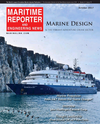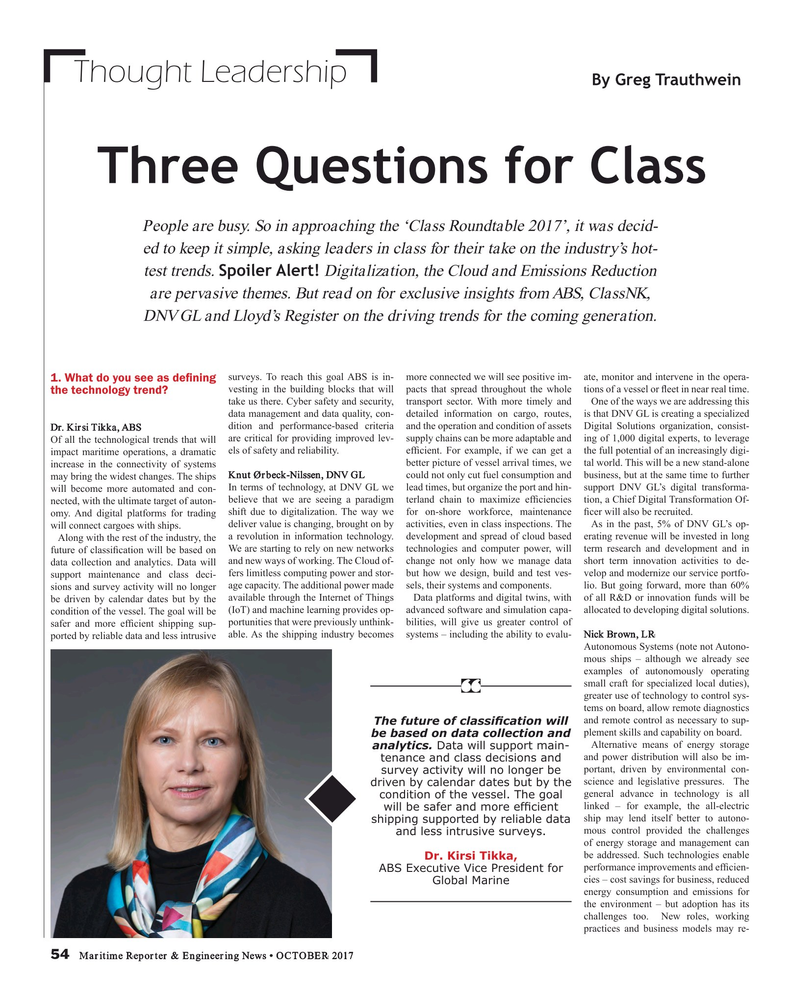
Page 54: of Maritime Reporter Magazine (October 2017)
The Marine Design Annual
Read this page in Pdf, Flash or Html5 edition of October 2017 Maritime Reporter Magazine
Thought Leadership
By Greg Trauthwein
Three Questions for Class
People are busy. So in approaching the ‘Class Roundtable 2017’, it was decid- ed to keep it simple, asking leaders in class for their take on the industry’s hot- test trends. Spoiler Alert! Digitalization, the Cloud and Emissions Reduction are pervasive themes. But read on for exclusive insights from ABS, ClassNK,
DNV GL and Lloyd’s Register on the driving trends for the coming generation.
surveys. To reach this goal ABS is in- more connected we will see positive im- ate, monitor and intervene in the opera- 1. What do you see as de? ning vesting in the building blocks that will pacts that spread throughout the whole tions of a vessel or ? eet in near real time. the technology trend?
take us there. Cyber safety and security, transport sector. With more timely and One of the ways we are addressing this data management and data quality, con- detailed information on cargo, routes, is that DNV GL is creating a specialized dition and performance-based criteria and the operation and condition of assets Digital Solutions organization, consist-
Dr. Kirsi Tikka, ABS
Of all the technological trends that will are critical for providing improved lev- supply chains can be more adaptable and ing of 1,000 digital experts, to leverage impact maritime operations, a dramatic els of safety and reliability. ef? cient. For example, if we can get a the full potential of an increasingly digi- better picture of vessel arrival times, we tal world. This will be a new stand-alone increase in the connectivity of systems may bring the widest changes. The ships Knut Ørbeck-Nilssen, DNV GL could not only cut fuel consumption and business, but at the same time to further
In terms of technology, at DNV GL we lead times, but organize the port and hin- support DNV GL’s digital transforma- will become more automated and con- believe that we are seeing a paradigm terland chain to maximize ef? ciencies tion, a Chief Digital Transformation Of- nected, with the ultimate target of auton- omy. And digital platforms for trading shift due to digitalization. The way we for on-shore workforce, maintenance ? cer will also be recruited. deliver value is changing, brought on by activities, even in class inspections. The As in the past, 5% of DNV GL’s op- will connect cargoes with ships.
Along with the rest of the industry, the a revolution in information technology. development and spread of cloud based erating revenue will be invested in long future of classi? cation will be based on We are starting to rely on new networks technologies and computer power, will term research and development and in data collection and analytics. Data will and new ways of working. The Cloud of- change not only how we manage data short term innovation activities to de- fers limitless computing power and stor- but how we design, build and test ves- velop and modernize our service portfo- support maintenance and class deci- sions and survey activity will no longer age capacity. The additional power made sels, their systems and components. lio. But going forward, more than 60% be driven by calendar dates but by the available through the Internet of Things Data platforms and digital twins, with of all R&D or innovation funds will be condition of the vessel. The goal will be (IoT) and machine learning provides op- advanced software and simulation capa- allocated to developing digital solutions. portunities that were previously unthink- bilities, will give us greater control of safer and more ef? cient shipping sup- ported by reliable data and less intrusive able. As the shipping industry becomes systems – including the ability to evalu- Nick Brown, LR
Autonomous Systems (note not Autono- mous ships – although we already see examples of autonomously operating small craft for specialized local duties), “ greater use of technology to control sys- tems on board, allow remote diagnostics and remote control as necessary to sup-
The future of classi? cation will plement skills and capability on board. be based on data collection and
Alternative means of energy storage analytics. Data will support main- and power distribution will also be im- tenance and class decisions and portant, driven by environmental con- survey activity will no longer be science and legislative pressures. The driven by calendar dates but by the general advance in technology is all condition of the vessel. The goal linked – for example, the all-electric will be safer and more ef? cient ship may lend itself better to autono- shipping supported by reliable data mous control provided the challenges and less intrusive surveys.
of energy storage and management can be addressed. Such technologies enable
Dr. Kirsi Tikka, performance improvements and ef? cien-
ABS Executive Vice President for cies – cost savings for business, reduced
Global Marine energy consumption and emissions for the environment – but adoption has its challenges too. New roles, working practices and business models may re- 54 Maritime Reporter & Engineering News • OCTOBER 2017
MR #10 (50-57).indd 54 MR #10 (50-57).indd 54 10/5/2017 1:26:14 PM10/5/2017 1:26:14 PM

 53
53

 55
55
